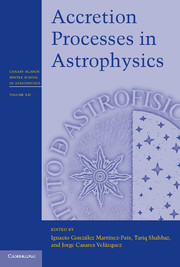Book contents
- Frontmatter
- Contents
- List of contributors
- List of participants
- Preface
- Acknowledgments
- Abbreviaions
- 1 Accretion disks
- 2 The evolution of binary systems
- 3 Accretion onto white dwarfs
- 4 Multiwavelength observations of accretion in low-mass X-ray binary systems
- 5 X-ray binary populations in galaxies
- 6 Observational characteristics of accretion onto black holes I
- 7 Observational characteristics of accretion onto black holes II: environment and feedback
- 8 Computing black-hole accretion
- A Piazzi Smyth, the Cape of Good Hope, Tenerife, and the siting of large telescopes
- References
2 - The evolution of binary systems
Published online by Cambridge University Press: 05 January 2014
- Frontmatter
- Contents
- List of contributors
- List of participants
- Preface
- Acknowledgments
- Abbreviaions
- 1 Accretion disks
- 2 The evolution of binary systems
- 3 Accretion onto white dwarfs
- 4 Multiwavelength observations of accretion in low-mass X-ray binary systems
- 5 X-ray binary populations in galaxies
- 6 Observational characteristics of accretion onto black holes I
- 7 Observational characteristics of accretion onto black holes II: environment and feedback
- 8 Computing black-hole accretion
- A Piazzi Smyth, the Cape of Good Hope, Tenerife, and the siting of large telescopes
- References
Summary
Abstract
One of the most important environments in which accretion disks are found occur in interacting binaries. In this chapter I review the main properties of binary systems and the most important types of binary interactions, stable and unstable mass transfer, the role of mass loss, mass accretion, and, in the most dramatic case, the merging of the two binary components. I particularly emphasize the evolutionary context in which these interactions occur and illustrate this using numerous examples of different types of binaries of current research interest. These include hot subdwarfs; symbiotic binaries; binary supernova progenitors, including the progenitors of type Ia supernovae and potential progenitors of long-duration gamma-ray bursts; low-, intermediate-, and high-mass X-ray binaries, containing both neutron stars and black holes; and their descendants, including binary millisecond pulsars, Thorne-Żytkow objects, and short-duration gamma-ray bursts.
2.1 Introduction
One of the main sites for accretion disks are interacting binary systems. Indeed, the majority of stars are found in binary systems, and in many cases (up to ~50%), they are close enough that mass flows from one star to the other, in many cases forming an accretion disk. This can happen for a wide variety of different systems: systems containing two normal nondegenerate stars, or one compact star (white dwarf [WD], neutron star [NS], or black hole [BH]), or even two compact stars of various combinations.
- Type
- Chapter
- Information
- Accretion Processes in Astrophysics , pp. 45 - 88Publisher: Cambridge University PressPrint publication year: 2014
References
- 6
- Cited by



